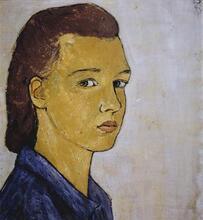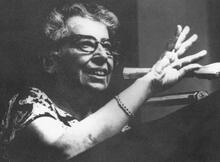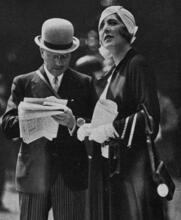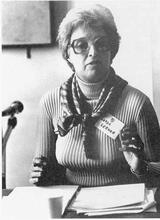Ilona Kronstein
Ilona (Ili) Kronstein was born in Budapest in 1897. In the early 1930s, she began focusing on her artistic training, working first as a graphic artist. Kronstein studied Japanese classical brush painting and the work of the impressionists. Beginning in 1933, with the financial support of her husband, Kronstein rented a studio to where she worked and ran a salon. When the Nazis came to power, she fled to the south of France, where she experienced a period of great artistic activity and growth and acquired a circle of artist friends. In 1942, she moved to Switzerland for medical treatment. Kronstein's work, which was not exhibited in her lifetime, was rediscovered in the 1990s and exhibited in Vienna at The Jewish Museum.
Early Life and Family
Ilona (Ili) Kronstein was born in Budapest, the eldest of three daughters of Sigmund (Zsiga) Neumann and Emma, née Deutsch. A second daughter, Margit (Manci), was born in 1899, and the youngest daughter, Klara (Klari), in 1903. Sigmund Neumann was a fairly successful entrepreneur in the textile business, but lacking in higher education and refinement; his wife, a quiet, sensitive woman, devoted herself fully to household and family. Circa 1908, when his textile firm went bankrupt, Sigmund moved with his family to Trieste, where Ili became fluent in Italian and also acquired a life-long affection for the country and its people. After the family’s return to Budapest, Ili was taken out of school at the age of sixteen and expected to prepare herself for marriage and a bourgeois life-style. Though she had shown an artistic talent from childhood on, her early work was ridiculed and discouraged by her father. She worked for several years as a volunteer in nursery schools for poor children. In 1919, despite initial parental opposition, she married Robert Kronstein and moved with him to Vienna, where he bought a pharmacy. Their first daughter, Gerda Hedwig, was born in 1920; the second daughter, Nora (named after Ibsen’s heroine), in 1925.
Ili and Robert’s marital life was full of tensions and contradictions, primarily because she longed to create around herself a sort of salon composed of interesting and progressive people. When they moved to a larger apartment during her first pregnancy, it was to the house in which her mother-in-law lived, where the sharp difference between the two women aroused disapproval of her artistic and bohemian tendencies. After Nora’s birth the couple came to a friendly agreement to live together in the same home, but not as man and wife, but he continued to support her throughout their lives.
Art Career
This agreement enabled Ili to develop as an artist and yet be economically secure. For many years she struggled for self-definition and artistic self-expression, first working at book-binding, then as a writer in German, her second language. In the early 1930s she began seriously to focus on her artistic training, working first as a graphic artist. Initially greatly influenced by the work of Egon Schiele, she later came under the influence of the teacher and artist Johannes Itten, with whom she studied either at his School of Living and Art in Berlin or during one of his periodic visits to Vienna. During the years 1934–36 she gave her older daughter informal art lessons that reflected Itten’s methods and views. In later years these same ideas informed not only her own work but also the advice she gave her younger daughter, who became an artist, as well as the written description of a painting course she had devised, which contains not only practical exercises but also philosophical ideas, such as the connection between yoga, breathing exercises, and art.
Ili educated herself as an artist by studying the work of the old masters during her frequent travels in Italy and elsewhere. She also studied Japanese classical brush painting and developed a great interest in the work of the impressionists, especially Cézanne. She was also very interested in German Expressionism in literature, film and art.
Beginning in 1933, with the financial support of her husband, Ili rented a studio, where she spent each day and many evenings at her work, and where she also ran a salon. She had several studio exhibits featuring her graphic work, portraits and landscapes, but her artistic development was forcefully interrupted by the Anschluss in 1938, shortly after which Robert moved to Vaduz in Liechtenstein, where he had founded a pharmacy in 1933.
World War Two
In one of the Nazi street raids, Ili was forced to clean the sidewalk and in April 1938 she and Gerda were arrested and jailed for six weeks as hostages for Robert. Before being released, she had to declare in writing that she and her children would emigrate immediately, but it took three months before they were able to leave Austria and join Robert.
The initial liberating sense of having escaped from Nazi power soon gave way to restlessness and unhappiness as she struggled with the uncultured provincialism of Vaduz and the lack of a studio. With Nora at a boarding school in Switzerland and Gerda having to go to Zürich to apply for a visa to the U.S.,
Ili decided to leave Vaduz and spend short periods in Zürich. There she shared a cheap, small room with Gerda, ate sparingly, but enjoyed the cultural amenities. However, both women were arrested and jailed as foreigners and threatened with deportation to Germany. Fortunately, Robert was able to change their destination to Liechtenstein.
Ili did not remain there for long. After a short stay in Paris, she moved to the south of France, where she lived through an extraordinary period of great artistic activity and growth. She began to work with color, her work deepened, and she turned increasingly toward cubism and abstraction. In Nice she acquired a circle of artist friends who inspired her and from whom she learned a great deal. Among these was the Latvian painter Rudolf Ray-Rapaport, with whom she developed a particularly close artistic and personal relationship.
Meanwhile, the family continued to plan emigration, but Ili’s application for a visa was finally rejected in June 1941. She had previously been interned for six weeks in Gurs together with ten thousand other Jewish and anti-Fascist refugees, among them Charlotte Salomon and Hannah Arendt. Here she displayed remarkable courage, good humor, and resourcefulness, but at the same time her health was steadily deteriorating. By the end of 1940 she was complaining of paralysis in her right arm, a symptom that eventually led to the diagnosis of multiple sclerosis in 1945. During 1941 she was unable to work for long periods, but she continued to draw as long as she could hold a pencil in her hand. In 1942, after Ray-Rapaport’s emigration to the U.S., she moved to Liechtenstein and then to Switzerland for medical treatment. She spent the last four years of her life in private care in Zurich, paralyzed but mentally alert. She died there on April 22, 1948, at the age of fifty-one. Her work, which was not exhibited in her lifetime, was newly discovered in the late 1990s and exhibited in Vienna at The Jewish Museum.
Catalog of an exhibition. “Die Welt der Ili Kronstein: Werke 1938–1943.” The Jewish Museum Vienna, December 12, 2000–March 25, 2001.










